Features of the salad variety of pepper "Bugai" and the secrets of its proper cultivation
Bugai salad pepper is a real find for those looking for an early ripe variety with sweet pulp. Beautiful and tasty, it is ideal for both greenhouse conditions and open beds. Most of the reviews about this variety are positive, summer residents and gardeners are satisfied with a good harvest.
Let's take a closer look at the description of the sweet pepper Bugai and find out the secrets of its cultivation.
The content of the article
What is this grade
An early ripe variety gives its first harvest 90-100 days after planting. Gardeners characterize the vegetable as juicy and very sweet; they actively use it to prepare various dishes.
Bushes are compact and powerful, reaching a height of about 60 cm.The leaves are dark green, slightly ribbed. For the best yield, the plant is formed 1-2 times per season. For the rest, care does not require special knowledge.
Fruit characteristics and yield
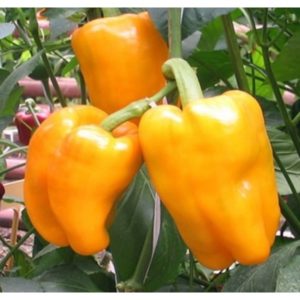
The variety got its name for the large size of the fruit - the weight of one pepper varies from 350 to 550 g. The color is bright yellow, in some cases light pink. The shape is cuboid, slightly flattened. The walls are up to 1 cm thick, so the peppers are well stored and transported.
The pulp is firm and fleshy, crunching when eaten fresh. The fruiting period of the variety is extended, on average, about 6 kg of pepper are collected from 1 bush.
Preparation for growing
The quality of the future harvest largely depends on the quality of the seed. Calibration will help to select the best seeds for planting - for this they are placed in a saline solution (50 g of salt per 1 liter of water). They are stirred for three minutes.
Those seeds that have sunk to the bottom are dried and used for further disinfection. It is necessary for the destruction of pathogenic microflora on the surface of seeds.
Gardeners recommend using one of the following drugs for disinfection: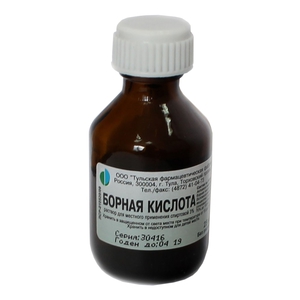
- aloe juice;
- Bordeaux liquid;
- copper sulfate solution;
- Fitosporin;
- boric acid.
The seeds are placed in a tissue bag and dipped in a prepared solution, left for 24 hours. Then they are taken out and put in a plastic bag for two days. This procedure increases the germination of the pepper and protects against disease.
Some summer residents advise to soak the seeds in a solution of the drug "Heteroauxin" afterwards. The growth stimulator strengthens the root system and promotes healthy plant development.
Important! Particular attention is paid to the preparation of the beds. Since autumn, the soil has been dug up, cleaned of debris and weeds. With the arrival of spring, the soil is re-dug up, large clods and foliage are removed. The soil is leveled with a rake and fertilized with compost or humus.
Growing seedlings
Seedlings are grown in any convenient containers. Special seedling cassettes are popular - small containers fastened together with drainage holes... They are easy to use and affordable. At the same time, the size of the cassette can be easily adjusted to any window sill by cutting off the extra cell with scissors.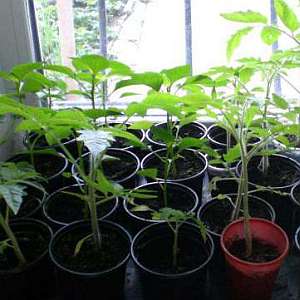
You can buy seedling cassettes at any gardening store. If this is not possible, then the seedlings are planted in peat tablets, flower pots, and plastic cups. The main thing is to thoroughly rinse the container before planting and wipe it with a clean towel.
For planting, in addition to containers, soil is required. Land from the garden, previously disinfected with a solution of potassium permanganate, is perfect.The soil is poured into a container, lightly slapped with fingers or a spatula. Small pits are made at a distance of 7-10 cm from each other, seeds are placed in them. Sprinkle on top with soil and watered with warm water.
Sweet peppers are a heat-loving vegetable, therefore, seedlings are stored only in a warm and sunny place.
Important! Pepper does not like excess moisture, so it is advised to water it in moderation. For irrigation, you can not use cold tap water; it is better to moisten the seedlings with bottled water or water from a filter. After 10 days from the moment of planting, the seedlings are fertilized with liquid organic fertilizing.
10 days after the appearance of the first leaves, the pepper is dived, that is, transplanted into a larger container. The procedure requires care and accuracy, since fragile and thin stems are highly sensitive. If possible, summer residents plant the vegetable immediately in a large container so as not to dive the seedlings and accidentally break them.
Planting pepper
Before planting each bush, carefully examine the root system of the seedling. Sometimes young plants get sick with root rot, which is why they are not suitable for planting. Sweet peppers are planted after herbs, legumes or cabbage. For disembarkation, choose the morning or evening, it is desirable that on this day there were no rains or fogs.
The seedlings are carefully removed from the container and, together with a lump of seedling earth, are placed in a hole in the garden bed. The stalk is sprinkled around with earth and watered abundantly with warm water. In regions with unpredictable climatic conditions, it is recommended to cover the bushes with a plastic bottle or plastic. Such protection is removed after the probability of frost has disappeared.
Important! The optimal distance between the bushes is 60 cm. It is not recommended to plant the plants too close to each other in order to prevent a lack of sunlight, which is necessary for normal development.
Care
Caring for the Bugai pepper variety consists of several procedures. The most important thing is timely and regular watering of the plant. It is produced 2-3 times a week: moisture should fall under the root of the plant, bypassing the leaves and stems. 1-2 liters of water are consumed for 1 bush.
It is important to prevent waterlogging of the soil, as this can lead to the development of fungi and infections. After the procedure, the plant is spud with moist soil. As soon as the ground dries up, they begin to loosen the row spacings. This helps protect the beds from weeds such as bindweed or dandelion.
The taste and quality of the fruit largely depends on the dressing, which is carried out twice a month. The following composition perfectly fertilizes pepper: 20 g of potassium chloride and 30 g of superphosphate are diluted in 10 liters of water. The mineral complex is brought in on a cloudy day, after which it is watered abundantly so as not to burn the leaves.
We must not forget about organic fertilizers. A mixture of water, slurry and wood ash has a positive effect on the vegetable. For the entire ripening period, the pepper is fed 3-4 times. Gardeners are advised to alternate mineral complexes and organic fertilizers.
Important! A month after planting the pepper in the garden, they begin to form a bush: too long side shoots are shortened, and all the leaves that shade the crown of the bush are removed. Pruning is carried out once a week.
Features of cultivation and possible difficulties
When growing a vegetable in a greenhouse, some rules must be followed. For example, regularly ventilate the structure by opening side vents and doors. As soon as the temperature outside reaches +30 ° C, the glass cover of the greenhouse is sprayed with a suspension of chalk from a spray bottle.
The greenhouse should be light, dark and shading surfaces are not allowed. Watering is carried out before lunch so that the moisture is evenly distributed. The greenhouse is characterized by a special microclimate, therefore, a good harvest can be achieved only if all the above rules are observed.
Particular attention is paid to loosening the soil.The quality of the soil and the healthy development of the root system depend on it. Loosening increases the access of oxygen to the soil, destroys the soil crust, and prevents weeds. Loose soil absorbs water better. Near the pepper, loosening is best done to a depth of 10-15 cm.
After the procedure, it will not be superfluous to add a layer of mulch to the beds. It protects the topsoil from weathering and pests. The best mulch composition is sawdust, bark and grass.
It is interesting:
How to dry bell peppers: preparing a healthy and delicious culinary ingredient.
Typical diseases and pests
No matter where it is grown, bell peppers are susceptible to insect pests. Most often found in the beds:
- Thrips- black bugs. They appear due to an oversupply of fertilizing and abrupt climate changes. As a preventive measure, spraying with Bordeaux liquid helps; for treatment, the "Oxyhom" agent is used.
- Whiteflies - are flying white midges that gather in flocks on leaves and suck juice from bushes. Spraying with soapy water helps in the fight against them.
- Spider mite - envelops the stems and leaves with white cobwebs, which is why the bushes dry out and the fruits lose their firmness. To prevent its appearance, use a solution of ash or water with salt.
- Colorado beetle - likes to feast on not only potato leaves. Beetles and larvae live deep underground all year round, it is difficult to get rid of them. Some gardeners prefer to collect insects by hand, others use Prestige.
Powdery mildew and black bacterial spot are isolated from diseases. They appear due to violations of the rules of crop rotation, with improper care, soil contamination.
In the fight against diseases, both folk methods and professional remedies help. A solution based on hot pepper or mustard, soapy water, as well as preparations "Arrivo" or "Nurel" are especially distinguished.
Advantages and disadvantages of the variety
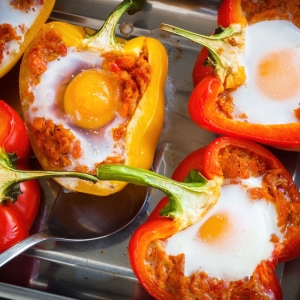
The main advantage of the Bugai variety is its large fruits and pronounced taste. Gardeners note the juicy and sweet pulp, which is suitable for preparing a variety of dishes. The pepper is used in salads, appetizers, soups and side dishes. The taste of the vegetable goes well with meat, poultry, fish and vegetables.
Also, the fruits look impressive and have beneficial commercial qualities. Thick walls allow you to store crops for a long time. In care, the Bugai variety does not require special skills, but the best harvest is obtained precisely on fertile and nutritious soils.
The disadvantage of the variety is that large fruits are not suitable for whole canning. Peppers do not fit in a jar, you have to spend time processing them. Also, occasionally Bugay is exposed to common cultural diseases, especially in the northern regions of the country.
Reviews
What do experienced gardeners and novice gardeners think of the Bugai variety? Here are some comments from popular forums.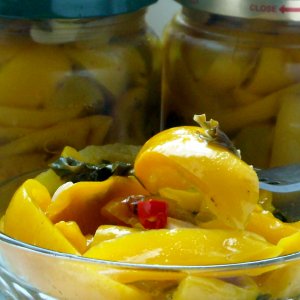
Irina, Omsk: «I like the variety, I have been growing it for 4 years. He has never been ill, always bears fruit well. I fertilize with manure and ash, the peppers grow large and juicy. They are tasty both fresh and after processing. "
Mikhail, Izhevsk: “I am planting bell peppers in a greenhouse, last season I planted the Bugai variety. The harvest is not bad, I collected 5-6 heavy fruits from one bush. It is stored perfectly, I recommend it for planting. "
Marina, Oryol: “The Bugai variety did not meet my expectations, the fruits were set slowly. After forming the bush, the plant got sick with powdery mildew. We managed to cure it, but part of the harvest was lost. "
Read also:
Pepper "Flight", ideal in appearance and amazing in taste.
Where and how to keep bell peppers for the winter: fresh, frozen, dried, dried and canned.
How to grow pepper Tenderness, time-tested and loved by gardeners.
Conclusion
For the best harvest, the Bugai variety is planted in seedlings. Seedlings are prepared in advance, put on a windowsill, periodically watered and fertilized. After transplanting to the site, the seedlings are covered with polyethylene or film. Take off the shelter after 2-3 weeks. In the process of growing, the beds are watered and fed with fertilizers.
Harvested from the beds in August, when the fruits become elastic. Store peppers in a dark and dry place. The variety is versatile in use, suitable for fresh consumption, for preparing vegetable salads and side dishes. Due to the high content of nutrients, the variety is also used for dietary nutrition.